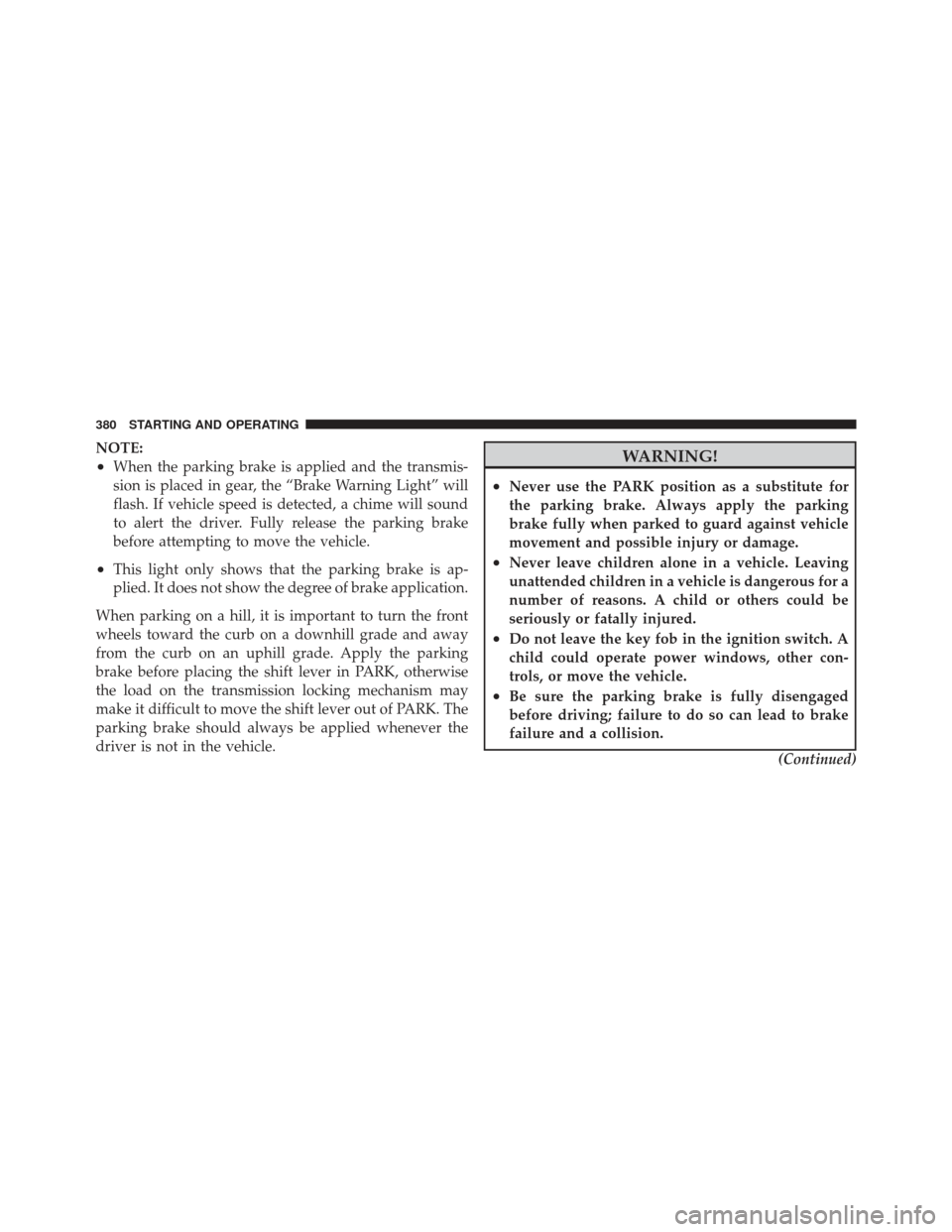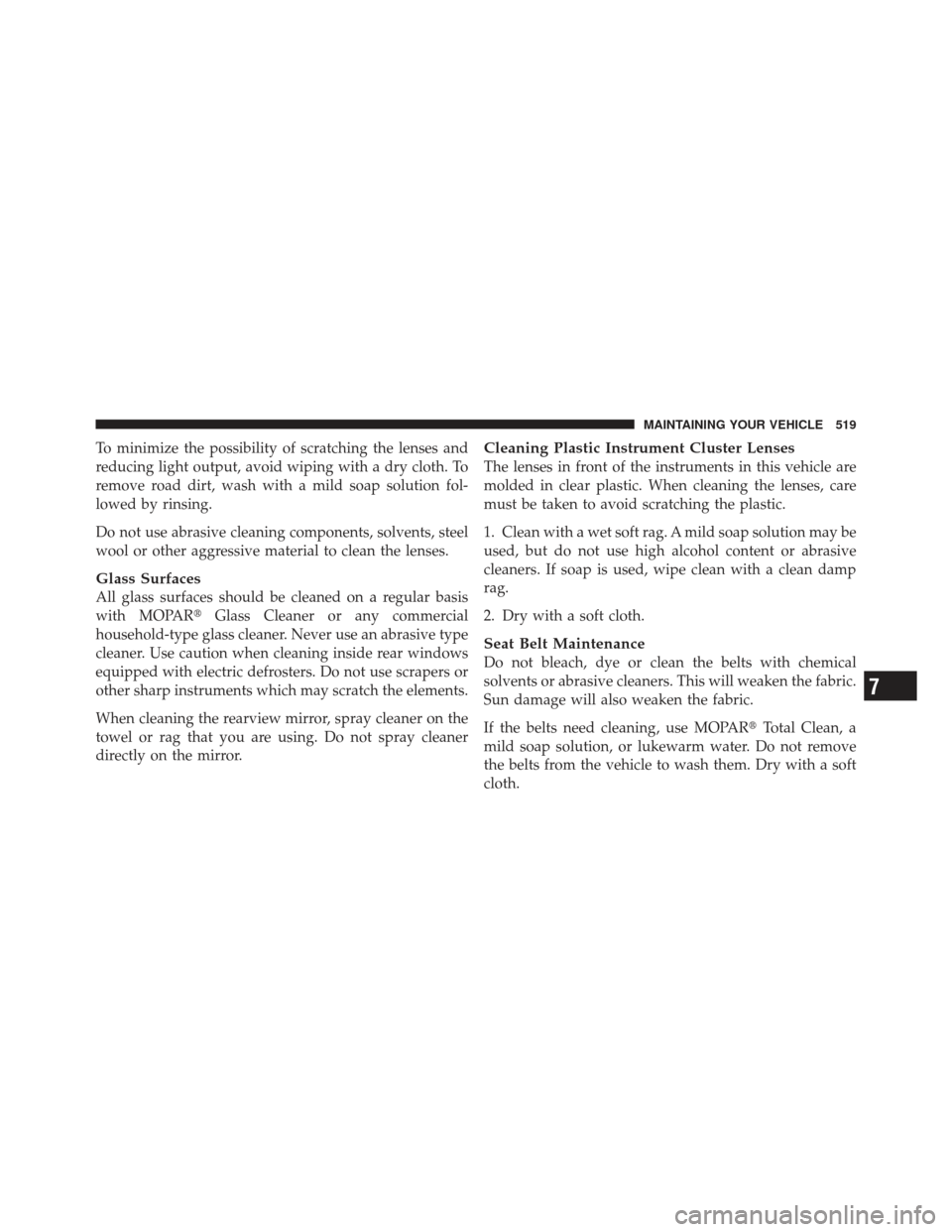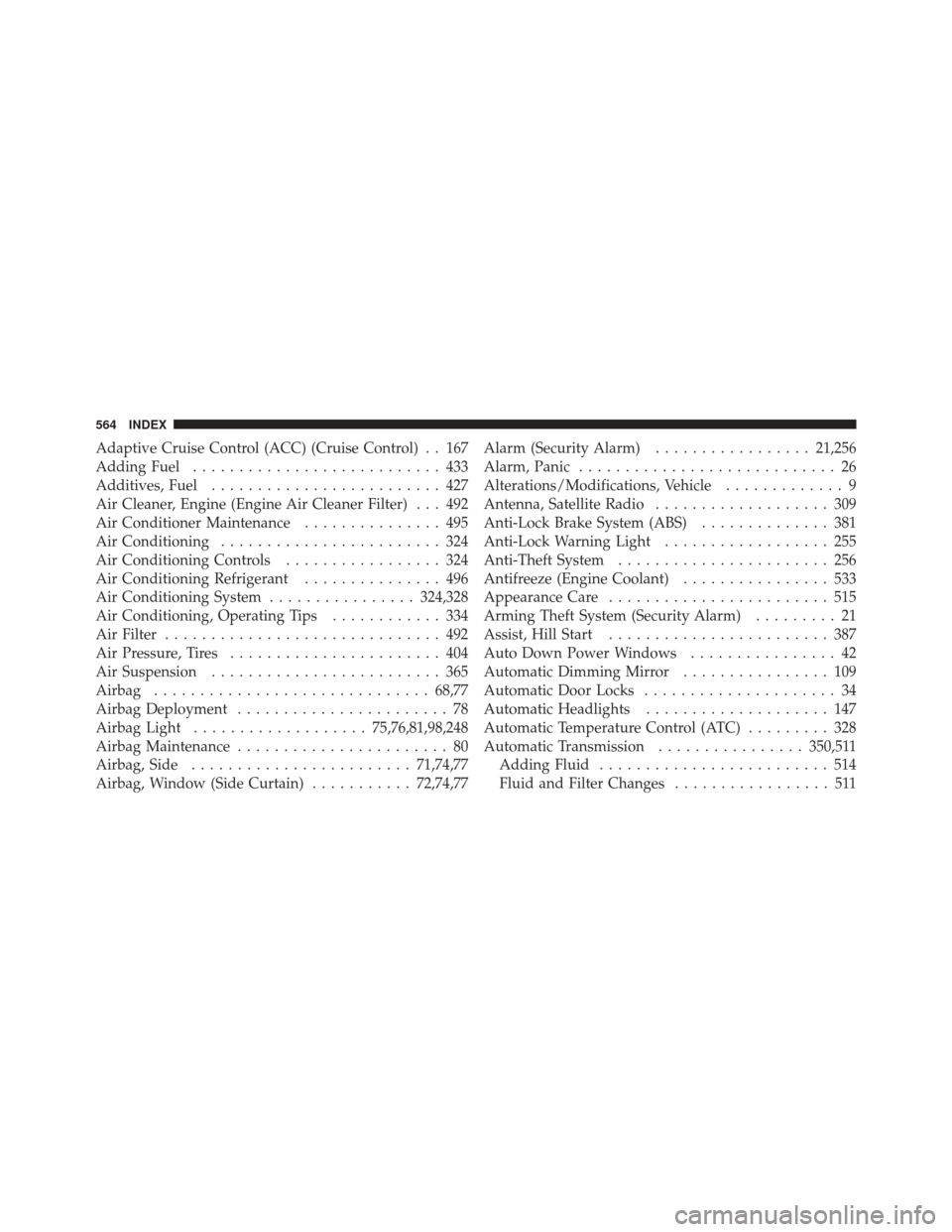Page 382 of 587

NOTE:
•When the parking brake is applied and the transmis-
sion is placed in gear, the “Brake Warning Light” will
flash. If vehicle speed is detected, a chime will sound
to alert the driver. Fully release the parking brake
before attempting to move the vehicle.
•This light only shows that the parking brake is ap-
plied. It does not show the degree of brake application.
When parking on a hill, it is important to turn the front
wheels toward the curb on a downhill grade and away
from the curb on an uphill grade. Apply the parking
brake before placing the shift lever in PARK, otherwise
the load on the transmission locking mechanism may
make it difficult to move the shift lever out of PARK. The
parking brake should always be applied whenever the
driver is not in the vehicle.
WARNING!
•Never use the PARK position as a substitute for
the parking brake. Always apply the parking
brake fully when parked to guard against vehicle
movement and possible injury or damage.
•Never leave children alone in a vehicle. Leaving
unattended children in a vehicle is dangerous for a
number of reasons. A child or others could be
seriously or fatally injured.
•Do not leave the key fob in the ignition switch. A
child could operate power windows, other con-
trols, or move the vehicle.
•Be sure the parking brake is fully disengaged
before driving; failure to do so can lead to brake
failure and a collision. (Continued)
380 STARTING AND OPERATING
Page 421 of 587

2. Installing some form of aftermarket window tinting
that affects radio wave signals.
3. Lots of snow or ice around the wheels or wheel
housings.
4. Using tire chains on the vehicle.
5. Using wheels/tires not equipped with TPM sensors.
NOTE:There is no tire pressure monitoring sensor in
the spare tire. The TPMS will not be able to monitor the
tire pressure. If you install the spare tire, in place of a
road tire, that has a pressure below the low-pressure
warning limit, upon the next ignition switch cycle, a
chime will sound, a “TIRE LOW PRESSURE” message
will be displayed in the instrument cluster for 60 seconds,
and the Tire Pressure Monitoring Telltale Light will turn
ON. After driving the vehicle for up to 20 minutes above 15 mph (24 km/h), the Tire Pressure Monitoring Telltale
Light will flash on and off for 75 seconds and then remain
on solid. In addition, a “SERVICE TPM SYSTEM” mes-
sage will be displayed for 75 seconds. For each subse-
quent ignition switch cycle, a chime will sound, a “SER-
VICE TPM SYSTEM” message will be displayed for
75 seconds, and the Tire Pressure Monitoring Telltale
Light will flash on and off for 75 seconds and then remain
on solid. Once you repair or replace the original road tire,
and reinstall it on the vehicle in place of the spare tire, the
TPMS will update automatically and the Tire Pressure
Monitoring Telltale Light will turn OFF, as long as no tire
pressure is below the low-pressure warning limit in any
of the four active road tires. The vehicle may need to be
driven for up to 20 minutes above 15 mph (24 km/h) in
order for the TPMS to receive this information.
5
STARTING AND OPERATING 419
Page 424 of 587

NOTE:Your system can be set to display pressure units
in PSI, kPa, or BAR.
If the ignition switch is cycled, this sequence will repeat,
providing the system fault still exists. If the system fault
no longer exists, the Tire Pressure Monitoring Telltale
Light will no longer flash, the �SERVICE TPM SYSTEM�message will not be present, and a pressure value will be
displayed instead of dashes. A system fault can occur by
any of the following:
1. Jamming due to electronic devices or driving next to
facilities emitting the same Radio Frequencies as the TPM
sensors.
2. Installing some form of aftermarket window tinting
that affects radio wave signals.
3. Lots of snow or ice around the wheels or wheel
housings.
4. Using tire chains on the vehicle.
5. Using wheels/tires not equipped with TPM sensors.
The EVIC will also display a
�SERVICE TPM SYSTEM�
message for a minimum of five seconds when a system
fault is detected possibly related to the trigger compo-
nent an incorrect sensor location fault. In this case, the
422 STARTING AND OPERATING
Page 431 of 587
WARNING! (Continued)
•Guard against carbon monoxide with proper
maintenance. Have the exhaust system inspected
every time the vehicle is raised. Have any abnor-
mal conditions repaired promptly. Until repaired,
drive with all side windows fully open.
•Keep the liftgate closed when driving your vehicle
to prevent carbon monoxide and other poisonous
exhaust gases from entering the vehicle.
FLEXIBLE FUEL (3.6L ENGINE ONLY) —
IF EQUIPPED
E-85 General Information
The information in this section is for Flexible Fuel ve-
hicles only. These vehicles can be identified by a unique
fuel filler door label that statesEthanol (E-85) or Un-
leaded Gasoline Only. This section only covers those
subjects that are unique to these vehicles. Please refer to the other sections of this manual for information on
features that are common between Flexible Fuel and
gasoline-only powered vehicles.E-85 Fuel Cap
5
STARTING AND OPERATING 429
Page 500 of 587

3. Grab the bottom of the wiper blade and rotate it
forward to unsnap the blade pivot pin from the wiper
blade holder.4. Install the wiper blade pivot pin into the wiper blade
holder at the end of the wiper arm, and firmly press the
wiper blade until it snaps into place.
5. Lower the wiper blade and snap the pivot cap into
place.
Adding Washer Fluid
On vehicles equipped with a Electronic Vehicle Informa-
tion Center (EVIC), the low washer fluid level will be
indicated. When the sensor detects a low fluid level, the
windshield will light on the vehicle graphic outline and
the “WASHER FLUID LOW” message will be displayed.
The fluid reservoir for the windshield washers and the
rear window washer is shared. The fluid reservoir is
located in the engine compartment, be sure to check the
fluid level at regular intervals. Fill the reservoir with
windshield washer solvent only (not radiator antifreeze).
When refilling the washer fluid reservoir, take some
washer fluid and apply it to a cloth or towel and wipe
1—WiperBlade
2 — Blade Pivot Pin
3—WiperArm
4 — Wiper Blade Holder
498 MAINTAINING YOUR VEHICLE
Page 521 of 587

To minimize the possibility of scratching the lenses and
reducing light output, avoid wiping with a dry cloth. To
remove road dirt, wash with a mild soap solution fol-
lowed by rinsing.
Do not use abrasive cleaning components, solvents, steel
wool or other aggressive material to clean the lenses.
Glass Surfaces
All glass surfaces should be cleaned on a regular basis
with MOPAR�Glass Cleaner or any commercial
household-type glass cleaner. Never use an abrasive type
cleaner. Use caution when cleaning inside rear windows
equipped with electric defrosters. Do not use scrapers or
other sharp instruments which may scratch the elements.
When cleaning the rearview mirror, spray cleaner on the
towel or rag that you are using. Do not spray cleaner
directly on the mirror.
Cleaning Plastic Instrument Cluster Lenses
The lenses in front of the instruments in this vehicle are
molded in clear plastic. When cleaning the lenses, care
must be taken to avoid scratching the plastic.
1. Clean with a wet soft rag. A mild soap solution may be
used, but do not use high alcohol content or abrasive
cleaners. If soap is used, wipe clean with a clean damp
rag.
2. Dry with a soft cloth.
Seat Belt Maintenance
Do not bleach, dye or clean the belts with chemical
solvents or abrasive cleaners. This will weaken the fabric.
Sun damage will also weaken the fabric.
If the belts need cleaning, use MOPAR� Total Clean, a
mild soap solution, or lukewarm water. Do not remove
the belts from the vehicle to wash them. Dry with a soft
cloth.
7
MAINTAINING YOUR VEHICLE 519
Page 533 of 587
Rear Liftgate Mounted Tail Lamp
1. Raise the liftgate.
2. Use a fiber stick or flat blade screw driver to pry the
lower trim from the liftgate.
3. Once lower trim is loose, close the liftgate.
4. Open the flipper glass.
5. Pull up glass seal at bottom of window opening.
6. Remove small trim panel around liftgate glass striker.
7. Close flipper glass and raise the liftgate.
8. Continue removing the trim.
9. Disconnect the two trim panel lights.10. Tail lamps are now visible. Rotate socket(s) counter
clockwise.
11. Remove/replace bulb(s).
12. Reinstall the socket(s)
13. Reverse process to reinstall the liftgate trim.
Rear Liftgate Tail Lamps
7
MAINTAINING YOUR VEHICLE 531
Page 566 of 587

Adaptive Cruise Control (ACC) (Cruise Control) . . 167
Adding Fuel........................... 433
Additives, Fuel ......................... 427
Air Cleaner, Engine (Engine Air Cleaner Filter) . . . 492
Air Conditioner Maintenance ............... 495
Air Conditioning ........................ 324
Air Conditioning Controls ................. 324
Air Conditioning Refrigerant ............... 496
Air Conditioning System ................324,328
Air Conditioning, Operating Tips ............ 334
Air Filter .............................. 492
Air Pressure, Tires ....................... 404
Air Suspension ......................... 365
Airbag .............................. 68,77
Airbag Deployment ....................... 78
Airbag Light ................... 75,76,81,98,248
Airbag Maintenance ....................... 80
Airbag, Side ........................ 71,74,77
Airbag, Window (Side Curtain) ...........72,74,77Alarm (Security Alarm)
.................21,256
Alarm, Panic ............................ 26
Alterations/Modifications, Vehicle ............. 9
Antenna, Satellite Radio ................... 309
Anti-Lock Brake System (ABS) .............. 381
Anti-Lock Warning Light .................. 255
Anti-Theft System ....................... 256
Antifreeze (Engine Coolant) ................ 533
Appearance Care ........................ 515
Arming Theft System (Security Alarm) ......... 21
Assist, Hill Start ........................ 387
Auto Down Power Windows ................ 42
Automatic Dimming Mirror ................ 109
Automatic Door Locks ..................... 34
Automatic Headlights .................... 147
Automatic Temperature Control (ATC) ......... 328
Automatic Transmission ................350,511
Adding Fluid ......................... 514
Fluid and Filter Changes ................. 511
564 INDEX